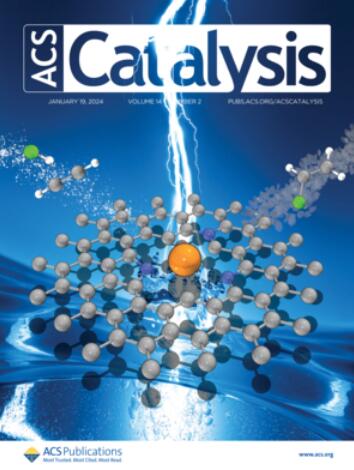在非均相双原子催化剂上,动态CO2吸附重构指导产物支化
IF 11.3
1区 化学
Q1 CHEMISTRY, PHYSICAL
引用次数: 0
摘要
过渡金属-氮-碳(M-N-C)框架的非均相双原子催化剂(dac)在电化学CO2还原中表现出很高的可调性,但其金属成分依赖性选择性的机制起源仍然难以捉摸。虽然传统的过渡金属(TM)基DACs主要产生CO,但战略性地加入主族金属(mm)可以使产品转换为甲酸,例如NiSn DACs。通过操作模拟恒势DFT和微动力学分析16种TMMM组合(TM = Mn/Fe/Co/Ni;MM = In/Sn/Sb/Bi),揭示了控制选择性的吸附二元机制。在工作条件下,从化学吸附的CO2到物理吸附构型的原位转变使反应途径转向*OCHO中间体而不是*COOH。这种动态重构源于双金属中心的不对称电荷积累,通过我们提出的电荷聚集强度(CAI)描述符进行量化。cai定向筛选确定NiSb DAC是生产HCOOH的有希望的候选物。我们的工作建立了原子尺度设计原理,将界面电荷积累与DACs中的动态吸附演化联系起来,为目标二氧化碳到化学转化提供了可靠的框架。本文章由计算机程序翻译,如有差异,请以英文原文为准。

Dynamic CO2 Adsorption Reconfiguration Directs Product Branching on Heterogeneous Dual-Atom Catalysts
Heterogeneous dual-atom catalysts (DACs) in transition metal–nitrogen–carbon (M–N–C) frameworks demonstrate high tunability for electrochemical CO2 reduction, yet the mechanistic origin of their metal composition-dependent selectivity remains elusive. While conventional transition-metal (TM)-based DACs predominantly yield CO, the strategic incorporation of main-group metals (MMs) enables a product switch to formic acid, as exemplified by NiSn DACs. Through operando-modeling constant-potential DFT and microkinetic analysis of 16 TMMM combinations (TM = Mn/Fe/Co/Ni; MM = In/Sn/Sb/Bi), we unravel an adsorption duality mechanism governing selectivity. Under working conditions, the in situ transition from chemisorbed CO2 to physisorbed configurations steers the reaction pathway toward the *OCHO intermediate rather than the *COOH. This dynamic reconfiguration originates from asymmetric charge accumulation at dual-metal centers, quantified through our proposed charge aggregation intensity (CAI) descriptor. The CAI-directed screening identifies NiSb DAC as a promising candidate for HCOOH production. Our work establishes the atomic-scale design principle linking interfacial charge accumulation to dynamic adsorption evolution in DACs, providing a reliable framework for targeted CO2-to-chemical conversion.
求助全文
通过发布文献求助,成功后即可免费获取论文全文。
去求助
来源期刊

ACS Catalysis
CHEMISTRY, PHYSICAL-
CiteScore
20.80
自引率
6.20%
发文量
1253
审稿时长
1.5 months
期刊介绍:
ACS Catalysis is an esteemed journal that publishes original research in the fields of heterogeneous catalysis, molecular catalysis, and biocatalysis. It offers broad coverage across diverse areas such as life sciences, organometallics and synthesis, photochemistry and electrochemistry, drug discovery and synthesis, materials science, environmental protection, polymer discovery and synthesis, and energy and fuels.
The scope of the journal is to showcase innovative work in various aspects of catalysis. This includes new reactions and novel synthetic approaches utilizing known catalysts, the discovery or modification of new catalysts, elucidation of catalytic mechanisms through cutting-edge investigations, practical enhancements of existing processes, as well as conceptual advances in the field. Contributions to ACS Catalysis can encompass both experimental and theoretical research focused on catalytic molecules, macromolecules, and materials that exhibit catalytic turnover.
 求助内容:
求助内容: 应助结果提醒方式:
应助结果提醒方式:


